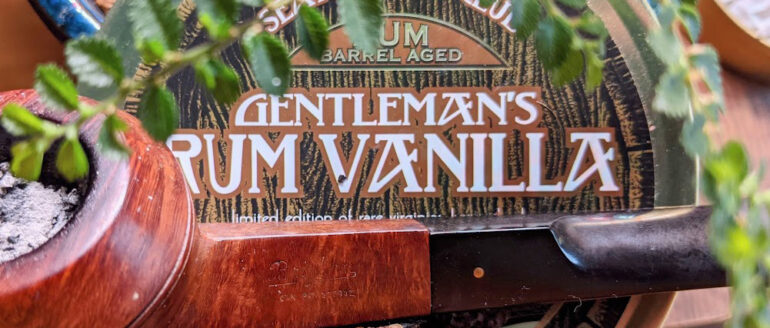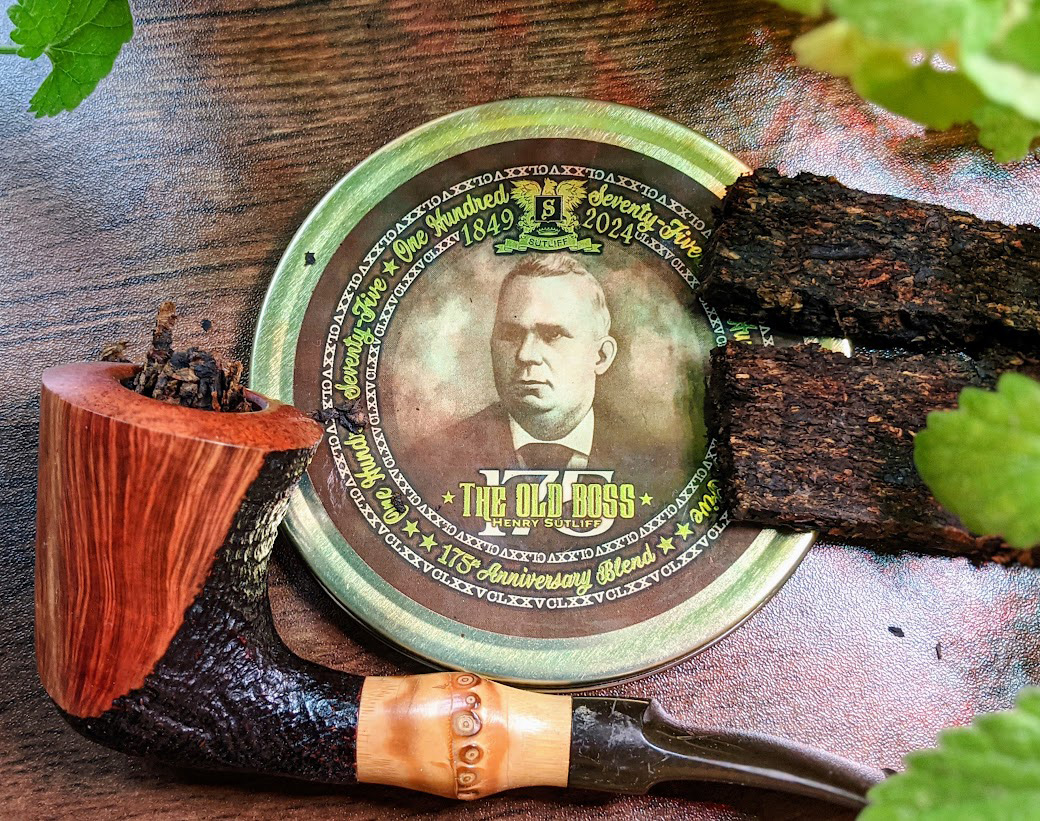
I’m a city boy through and through; I’d always thought of plants as either the green background of the generalized concept of “nature”, or specifically the products we extract from them: lumber, food, and of course fine boutique tobaccos. Until recently, that is. A red oak acorn gathered from a place of some significance to me took root this winter, and with it grew a sudden appreciation and fascination with the world of botany. It gives me real joy to learn how to listen to plants, understand how to nurture them, and contemplate how growth is a reflection of their struggle through life. In my horticultural endeavor I find the same peaceful zen practice that I also seek while enjoying a pipe. My houseplants have been thriving in the early heat, and practicing some planty chores while taste testing a variety of recent releases helps maintain some balance and equanimity in an otherwise chaotic world.
Sutliff has been churning out new concoctions left and right lately, so let’s take a brief look at two of them. The first piqued my interest as it delves into the past, resurrecting a blend from Sutliff’s estimable vault: 175th Anniversary Blend“The Old Boss”. It’s very much a blend for a clencher; one can imagine the eponymous gentleman pictured steadily puffing like a steam locomotive while reviewing quarterly budgets, then stalking through the factory floor with a stern vigilance on his face.

Celebrating our 175th Anniversary, it was only fitting to bring back The Old Boss, presented with founder Henry Sutliff’s portrait just as it was over a century ago. We dug into our vault for an old classic. Before Mixture No. 79, before Heine’s Blend, there was The Old Boss—a Latakia heavy English with the finest Red Virginias and Turkish leaf, a touch of Perique for spice, and Burley to round the edges. Light up and enjoy this throwback and celebrate 175 years with us.
“Latakia heavy” is a diplomatic way to phrase it, as the first rush from the tin attests that ol’ Henry is either about to give you a promotion or a pink slip. Notes of waxy leather, a hint of graham cracker, salty driftwood, and old ledgers dominate the bouquet, as if this blend was formed by invoking the ghost of Mister Sutliff and importing it directly into the tin. Despite the vintage heaviness implied by the aroma, in the bowl it is a surprisingly gentle smoke. Presented in thick and loosely-pressed crumble-cake slices, it requires some drying time to prepare. Once packed it tends to stay lit easily and smoke down to dregs without too much tending, even in a capacious bowl like the Savinelli Autograph pictured. Like the tin art, it stays squarely in the vintage vein of flavors true to the bouquet; the tobaccos are balanced in such a measure to downplay sweet notes while not letting the Latakia overwhelm, instead leaning into the woody and leathery end of the spectrum through to the heel. The Turkish leaf steers the experience, the Perique is more an impression than a top spice, and there, at the end, a hint of roasted chestnut from the burley; a lightly floral vanilla that lingers on the palate between puffs. All in all it’s a very sturdy and enjoyable blend that delivers on its claims, worth adding to an order to try something new but perhaps not to cellar deeply.
Shifting gears for a moment, next we sample the latest limited edition from the Seattle Pipe Club marque: Gentleman’s Rum Vanilla. The tin aroma is indeed refined in a gentlemanly sort of way, with rich sweet rum and vanilla wrapped in dark woody overtones, and again presented in thickly-sliced krumble cake. Notably, the tin contains a full two ounces of tobacco described as:

This exclusive blend features loose cut rare Brazilian and domestic Virginias, luxury Burley and sweet black Cavendish meticulously slow aged for a full 30 days in oak rum barrels.
Preferring to lounge in my club chair with a notebook and smoking jacket for this tasting, it’s easily crumbled and well-suited to a Brigham patent-era bulldog. Still rather moist in the tin, I prefer giving it enough drying time that it won’t stick together when pinched but not so dry that it will crush. Sutliff certainly has dialed in on making a rich and redolent Cavendish, with exquisite top dressing and real depth from being barrel-aged. The smoke was consistent top to heel, never biting, though best sipped to keep it from turning toward sour. A perfect smoke for mixed company, it delivered great flavor as well as room note. I found it paired best with unflavored seltzer to wash the palate and give a hint of salty counterpoint. Digging toward the bottom of both Sutliff tins also led to a bit of heresy—namely, mixing the vanilla in with the English in equal portion—and I dare say they each improved the other. “The Old Gentleman’s Rum Bossilla” could be a thing…maybe. I’m sure Joe would approve.
Finding the time to also sample a GL Pease blend that had flown under my radar, Penny Farthing ended up in my basket on a recent stop at Barclay-Rex. Something from Greg’s laboratory is generally a safe bet; I haven’t found any that I hate yet, at least. There are many that I love and cellar deeply—Cairo perhaps above them all; the JackKnifes(jackknives?) and Triple Play, of course; new favorite géométrie, recently reviewed here. Tons of Haddo’s Delight, natch. Now, in Penny Farthing, I’ve found one to add to the “when I feel like smoking it, nothing else will do” list.

Slotted into the brand’s Old London series, Penny Farthing is a diametric departure from plug tobaccos, a style that many of the GLP offerings re-energized in the US market:
A shag-cut blend of bright and red Virginias, spiced with Louisiana Perique and a hint of fire-cured dark Kentucky, easy to pack, easy to smoke. Sipped gently, Penny Farthing opens with a sophisticated sweetness, evolving in depth and complexity throughout the bowl to a rich, satisfying finish.
Opening the tin, one is greeted by a bramble of shag that is sliced thin as lace and rich in aroma. The constituent tobaccos here are wonderfully married in proportions, with the dark-fired provoking a musty, truffley, smoky background that enhances the fruity sweetness and high tannic notes from the Virginia. While primarily a Virginia blend, it’s the dark-fired that shapes it, inhabiting the space that Latakia might instead, in character and proportion; a light English blend without Lat, effectively. It drives the smoke’s complexion, gives it weight, yet still allows the other leafs ample interplay, never overshadowing the tart lemony highlights of the Virginia or the peppery spice from the Perique.
The shag cut is, naturally, what makes this blend so special. Such a fine cut is deliciously easy to smoke, yet will not fare well in many bowl shapes and sizes. While my testing meer is a cutty, its capacious bowl proved orders of magnitude too large to do service to what the blend has to offer. In the diminutive Dawnmist clay cutty or the adroitly petite Dunhill Zulu 1421, however, it may only last a dozen or so sips, but what delicious sips they are; a group 1 or 2 bowl seems to be the perfect spot for this shag to give its best performance. Enjoyed in these conditions it has it all: balance, nuance, occasional drama, and a good amount of nicotine to back it up—further recommending a smallish pipe to get the best of repeated bowls. I gravitated toward iced latte pairings in the afternoons, but could be persuaded to have a few short bowls with hot morning coffee as well. I’ll be cellaring a few of these.
My plants don’t seem to mind that I smoke and talk to them, and I appreciate their silent regard. I haven’t ventured to grow tobacco yet, but tea camellias and coffee plants are in my collection. A garden of vice, if you will. It’s also a new appreciation of the secret life of plants, and gives fresh perspective on the experience of tasting tobacco. It feels like it will be a summer of varieties, and these three blends were a great start.
Continuity of purpose in caring for, nurturing something and helping it grow…something like that. Komorebi.















